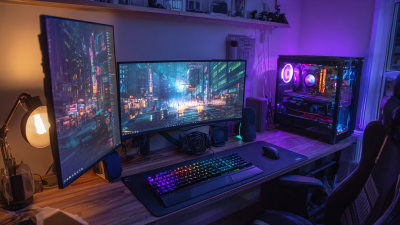Leave Your Message
- Phone
- E-mail
- Whatsapp


In today's fast-paced digital world, effective communication has never been more critical, particularly in the realm of presentations. According to a recent report by TechCrunch, the use of advanced display technologies, including Direct Screen Display, can improve audience engagement by up to 70%. This enhancement is crucial as research from Gartner indicates that 75% of executives consider effective presentation skills an essential component of business success. By incorporating Direct Screen Display technology, presenters can create immersive and visually appealing experiences that captivate their audience and facilitate better retention of information. As businesses continue to adapt to remote and hybrid work environments, leveraging innovations in presentation technology will be key to maintaining a competitive advantage and ensuring impactful communication.

 Direct screen display technology is revolutionizing the way presentations are conducted, moving beyond traditional projection methods to deliver a more engaging experience. According to a report by MarketsandMarkets, the digital signage market is projected to reach $31.71 billion by 2025, highlighting the growing adoption of direct display systems in corporate, educational, and entertainment sectors. This technology allows presenters to directly connect their devices to larger screens, providing clearer visuals and minimizing latency, which enhances audience engagement and comprehension.
Direct screen display technology is revolutionizing the way presentations are conducted, moving beyond traditional projection methods to deliver a more engaging experience. According to a report by MarketsandMarkets, the digital signage market is projected to reach $31.71 billion by 2025, highlighting the growing adoption of direct display systems in corporate, educational, and entertainment sectors. This technology allows presenters to directly connect their devices to larger screens, providing clearer visuals and minimizing latency, which enhances audience engagement and comprehension.
The integration of direct screen display technology into presentations also caters to the increasing demand for interactive and visually compelling content. Research from Gartner indicates that interactive presentations can increase audience retention rates by up to 65%, a significant improvement compared to conventional lecture methods. By leveraging high-definition displays, touch interactivity, and real-time content sharing, presenters can create dynamic experiences that resonate with diverse audiences, making complex information more accessible and memorable. As organizations continue to recognize the importance of effective communication, investing in direct screen display technology represents a strategic move to enhance presentation effectiveness and drive better outcomes.
When enhancing presentations with direct screen display technology, selecting the right equipment is crucial for achieving optimal display performance. One key consideration is the compatibility of the projector or screen with the source device. Ensuring that the resolution matches between devices will not only preserve image quality but also enhance the overall viewing experience for the audience. High-definition projectors and screens capable of displaying 4K content are increasingly becoming the standard, so investing in such technology can significantly elevate the visual impact of your presentation.
Another important factor is the brightness and contrast ratio of the display equipment. Depending on the environment, such as a brightly lit conference room or a dimly lit seminar hall, the brightness level needs to be adequate to maintain clarity and visibility. A projector with at least 3000 ANSI lumens is often recommended for versatile use in various lighting conditions. Additionally, choosing displays with a high contrast ratio will ensure that colors appear vivid and texts are legible, further capturing your audience's attention and enhancing their engagement with your content.
Creating engaging visuals for direct screen presentations is essential for capturing your audience's attention and conveying your message effectively. The design of your visuals can significantly impact retention and engagement, so it's crucial to focus on clarity and appeal. Use high-contrast colors and legible fonts to ensure that your text is easily readable, even from a distance. Incorporate imagery that complements your content and avoids overcrowding slides with excessive text.
Tips for enhancing your visuals include utilizing bullet points to break down complex information, which makes it easier for your audience to follow along. Opt for high-quality images and graphics that align with your topic, ensuring they are relevant and insightful. Additionally, using animations and transitions sparingly can add a professional touch while maintaining a smooth flow without distracting from your primary message.
Another effective strategy is to tell a story through your visuals, guiding the audience on a journey that highlights key points. This emotional connection can make your presentation more memorable. Incorporate charts and infographics to transform data into an engaging narrative, helping your audience grasp complex ideas at a glance. Overall, consider these approaches to develop engaging visuals that enhance your direct screen presentations.
| Dimension | Description | Importance |
|---|---|---|
| Visual Aids | Use of images, diagrams, and videos to enhance understanding. | High |
| Text Clarity | Clear, concise text that complements visuals without overwhelming. | Medium |
| Interactivity | Engaging the audience through questions or live polls. | High |
| Consistent Theme | Maintaining a cohesive look and feel throughout the presentation. | Medium |
| Use of Color | Appropriate use of color to highlight key points and improve readability. | High |
Integrating interactive elements into presentations can significantly boost audience participation and engagement. One effective way to achieve this is by utilizing direct screen display technology, which allows presenters to showcase visuals and interact with their content in real time. For instance, using tools like live polls or quizzes, presenters can encourage audience members to contribute their opinions and thoughts instantly. This not only transforms a passive listening experience into an active conversation but also helps to gauge audience understanding and interest, allowing for adjustments during the presentation.
Moreover, incorporating interactive features such as touchscreen interfaces or audience response systems can foster a collaborative environment. These technologies enable participants to ask questions, share insights, or even navigate through the presentation content themselves. By integrating such elements, presenters can create a more dynamic experience that resonates with diverse learning styles and preferences. Ultimately, the combination of direct screen display technology with interactive components leads to richer dialogue, enhanced retention of information, and a more memorable presentation overall.
When setting up direct screen displays for presentations, the first step is to ensure compatibility between your devices and the display technology. Using wireless display options can eliminate clutter and provide flexibility in movement during your presentation. Make sure to test the connection beforehand to avoid technical glitches. Engage your audience by strategically positioning screens so that everyone has a clear view. This might involve using multiple screens or a larger central display, depending on the size of the venue.
Effective management of direct displays is equally crucial. Utilize software that allows for seamless transitions and easy manipulation of content. It’s important to incorporate multimedia elements to keep the audience engaged, but be careful not to overwhelm them. Schedule time for interactive elements, such as Q&A sessions or live demonstrations, to foster a more immersive experience. Remember to practice using the display system, which will help you become familiar with any potential challenges and solutions, ensuring a smooth presentation flow.







